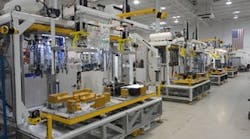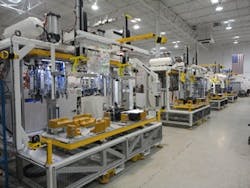Money on the table: Taking advantage of the R&E tax credit
At Industrial Automation, a system integrator with facilities in Michigan, Kentucky, Alabama and Mexico, a history of failed tax-credit pursuits had soured management’s taste for further attempts. “We were all quite skeptical,” says Mark L. Gust, co-owner and CEO of Industrial Automation. “Our company began working with Clayton & McKervey shortly after the firm was identified by our bankers as a specialist in U.S.-Mexico corporate strategy and organization. We had previously hired a nationally recognized firm to pursue research-and-development tax credits; no usable benefits were generated, and no refunds were received. We didn’t want to invest more time and energy into what we had previously determined to be of no value. Thankfully they were persistent and convinced us that the process would generate refunds and future credits. During the restructuring of our entities, the team at Clayton & McKervey identified that we were not utilizing our research-and-development tax credits optimally, as supply costs weren’t being captured appropriately.”
Figure 1: An automated cell for a door-panel machine contained components that qualified as supply costs, which weren’t being captured appropriately as tax credits.
(Source: Industrial Automation)
Gust attributes the difference between success and failure as an understanding of the tax law and a willingness by the firm to fully grasp the nature and operation of Industrial Automation’s business (Figure 1). “During the process, Clayton & McKervey introduced engineers and industry experts into the exploration,” explains Gust. “This team knew what to look for and the right questions to ask. Additionally, they didn’t interfere with our ongoing day-to-day business. They would briefly interview our employees to gather the information required to meet the requirements and create their reports. We received hundreds of thousands of dollars in refunds from the IRS and significant state refunds. We’ve amassed vast credits that we will use going forward, and we’re currently using credits for our federal taxes. This is dramatically improving our cash flow and income.”
Often called R&D, the research and experimentation (R&E) tax credit is a tax incentive that can provide tax benefits for companies investing in research and development. The majority of machine builders, tool-and-die shops and system integrators are not utilizing this tax incentive to the fullest extent, even though, according to the IRS Statistics of Income, more than $10 billion of federal R&E tax credits are claimed annually.
Due to the technical nature of their work, companies in the business of improving industrial production processes, through controls and automation or the integration of multiple systems, are some of the best candidates for the credit. Machine shops, tool and die shops as well as custom machine manufacturers may also receive a large benefit from the credit due to production and design activity common to these industries. We often see companies in these industries save hundreds of thousands of tax dollars through proper utilization of the tax credit. Full utilization of the credit can have a positive impact on cash flow. Companies are able to absorb lower margins on qualified projects due to the ability to lower their effective tax rate through maximum utilization of the credit. While the lower margins have decreased earnings before taxes, cash flow has increased due to the lower tax liability.
At the end of 2015, the Protecting Americans from Tax Hikes Act (PATH Act) made the R&E credit permanent, giving taxpayers greater flexibility to properly plan and prepare for an R&E study to ensure they’re able to maximize the credit. The PATH Act also put in place provisions that provide companies with less than $50 million in revenue a greater benefit than was available under the previous regulations.
Common Misconceptions
The company must invent something revolutionary or patentable: The single biggest misconception surrounding the R&E credit relates to what is considered to be qualified activity. Taxpayers hear the term R&E and often think they must be inventing something entirely new or groundbreaking in order to qualify for the credit. In reality, the taxpayer only needs to be engaged in an activity that is evolutionary to them. Such activity includes improvements to existing products or processes, as long as the activity is intended to eliminate uncertainty.
Failed projects do not qualify for R&E credits: The regulations specifically state that success is not required in order to be eligible to claim the credit. In fact, proof of failure supports your R&E credit claim as it provides documentation of your intent to eliminate uncertainty.
My company is not profitable and won’t benefit from the R&E credit: The credit is not a refundable tax credit; therefore it is true that the company must be profitable to utilize the credit. However, if your company is structured as an S corporation or limited liability corporation (LLC), you can include the wages of active owners when assessing whether you will be able to utilize the credit.
In addition, the credit can be carried forward 20 years and back one year. If you think you have qualifying activity and haven’t claimed the credit, you may have the ability to amend prior returns and claim a refund of taxes previously paid. If the company has incurred losses in previous years, we often recommend a company to review whether they have qualifying activity at least a year before they are projecting profitability. This will help to ensure they are ready to fully utilize the credit in the first year of profitability.
In addition, small startup companies may now be able to claim a credit against their payroll tax even if they pay no income tax.
We are already deducting expenses related to R&E so I don’t think the benefit will be that great: Taxpayers are often confused by the difference between a tax deduction and a tax credit. In general terms, a credit is worth more than a deduction. For example, if your company is a C corporation, a deduction results in reduced tax liability equal to 35% of the deduction. By comparison, a credit offers a dollar-for-dollar reduction in tax liability. The regulations surrounding the R&E credit allow the taxpayer to take a deduction for qualified R&E expenses and a reduced R&E tax credit. Therefore if you only take the tax deduction, you are leaving money on the table.
ALSO READ: The real impact of robotics and automation advancements
What type of activity qualifies?
The IRS defines the term qualified research activity with a four part test. The test requires that:
- the activities involve the elimination of uncertainty concerning the development or improvement of a product, to that the expenses of the activities are deductible under Section 174 of the Internal Revenue Code (Sec. 174 test)
- the activities are useful in the development of a new or improved business component (business component test)
- the activities discover information that is technological in nature (discovery test)
- the activities are experimental in nature and conducted for a permitted purpose (process-of-experimentation test).
Each activity must pass all four tests to be considered a qualified activity.
What exactly does this mean? In general, research is conducted for a qualified purpose if it relates to a new or improved function, performance, reliability or quality. Research is not conducted for a qualified purpose if it relates to style, taste, cosmetic or seasonal design factors. The four parts in the test above are explained in greater detail below.
Sec. 174 test: Qualified research expenditures are defined in IRC Section 174 and generally include costs incidental to the development or improvement of a product, process, formula, invention, technique, patent or similar property. The test looks to the nature of the activity. To meet this test the expenditure must:
- be incurred in connection with the taxpayer’s trade or business
- represent a research and development cost in the experimental or laboratory sense.
This language is often confusing to taxpayers. The activity is not required to take place in a laboratory; the taxpayer must merely document the methods used to discover new information and eliminate uncertainty. This test is also met if the information eliminates uncertainty that has already been discovered but is not available to the taxpayer.
Business component test: This test requires that the taxpayer’s activities be useful in the development of a new or improved business component. A business component means any product, process, computer software, technique, formula or invention that is held for sale, lease or license used in a trade or business. A production process or manufacturing technique is also an example of a business component.
Discovery test: The discovery requirement is satisfied if the research is “intended to eliminate uncertainty concerning the development or improvement of a business component.” The test focuses on the technical nature of the activity rather than the methodologies used (as the Sec. 174 test focuses). The test is taxpayer-focused, rather than industry-focused, which means it does not matter if another company has developed the product or process. If there is an element of uncertainty in the activity you are engaging, it may be qualifying activity. Eligibility does not depend upon the ultimate success, failure, sale or use of the product. Typically costs are eligible until the element of uncertainty is eliminated.
Process-of-experimentation test: The process-of-experimentation test requires a facts-and-circumstances analysis; however, the IRS has provided three core elements that are needed to satisfy this test:
- identifying uncertainties
- identifying alternative solutions
- evaluating the identified alternative.
If your process includes all three steps, it is likely a qualifying activity.
In 2003, the IRS loosened the process of experimentation qualifications. Under the current regulations, development efforts only need to be evolutionary to you. In other words, if employees in your organization are spending time to discover technical information through research and experimentation, with the intention of developing or improving products or trade processes, those expenses will generally be qualified research and development costs for purposes of the credit.
Many companies aren’t aware that a product or process merely needs to be evolutionary to them in order to qualify. In addition, we have encountered many companies who are utilizing the credit, but not to the fullest extent. Underutilization of the credit often happens because a taxpayer has not properly identified all projects with qualifying activity and has not included all qualifying expenses in the credit calculation.
Qualified expenses
The IRS provides specific guidance related to expenses that are considered to be deductible research expenses. In general, qualified research expenses equal the sum of in-house research expenses plus contract research expenses. In-house research expenses include:
- wages paid or incurred to an employee for qualified services performed by the employee (wages include the earned income of self-employed taxpayers)
- expenses incurred for supplies used in the conduct of qualified research (supplies include any tangible property other than property for which depreciation deductions are allowable).
Identifying qualifying expenses is usually an area most taxpayers misunderstand. Costs incurred in the development or improvement of a plant process, a product and a technique are all qualifying expenditures. To put that into context, a system integrator often improves a product or technique for each automation cell produced. A machine builder often builds a machine per customer specifications, which require design and engineering work. In that regard, the costs incurred to engineer and test a cell or machine would be qualified expenses. If the cell is duplicated, only the costs incurred for the first cell would be qualified; however, it has been our experience that most cells have something unique to them.
If you drill down even further and question what type of costs are considered research costs for purposes of calculating the credit, you would find that many supply costs are also included in the definition of qualified expenditures. We have found supply costs are often an overlooked expenditure for purposes of the credit calculation, and often these are the largest costs incurred in the development of an automation cell.
Qualified costs only include the costs incurred during the research and development process. Costs incurred after the product is ready for commercialization are not qualified costs. Examples of unqualified costs include preproduction planning and trial production runs, engineering follow-through or trouble shooting during production, or adaptation of an existing capability to a particular requirement or customer’s need as part of a continuing commercial activity. In addition, expenditures for research that’s conducted outside the United States are not qualified expenses.
Practical advice for determining whether a project is qualified: Taxpayers often read the definitions and are still uncertain whether their activities would be considered qualified research. Typically the taxpayer must bear an element of risk. In the context of a custom machine builder, system integrator or tool-and-die company, generally, if a project must go through the Production Part Approval Process (PPAP) with your customer, chances are high that it is a qualified project. Conversely, projects that are billed based on time and material, such as engineering service contracts, would likely not be considered qualified activity.
How much is the credit?
Typically the credit will be about 6.0% - 6.5% of qualified research expenditures. Prior to the PATH Act, the credit expired each year and required an annual extension to be passed by Congress. Most recently, such extensions did not occur until the end of the year, making it difficult for taxpayer to properly plan for the credit. Such uncertainty caused many taxpayers to ignore the credit altogether. In addition, prior to the PATH Act, the credit could not be utilized to offset alternative minimum tax, which greatly reduced the benefit of the credit. In addition to making the credit permanent, the PATH Act also allows the credit to offset alternative minimum tax.
This change makes the credit much more beneficial to taxpayers engaged in qualifying activity as it can now bring the taxpayer’s effective tax rate down to about 7.5%. To translate this benefit to real dollars, a C corporation with $1 million of taxable income would pay income tax of $350,000, if it did not claim the R&E credit. If the C Corporation has qualifying activity, the R&E credit could bring the tax liability down to $75,000, saving $275,000 of tax dollars.
What type of documentation is needed to support the credit? An R&E study should be done to support any credit claim and ensure you meet the documentation requirements required by the IRS. Studies are usually fixed-fee engagements, and the cost will range from 25% to 30% of the credit, depending on how much documentation you maintain and how complex the research activity is. The cost of the study is tax-deductible.
Meet with your bank to explain the positive impact the study will have on net cash flow, especially if you plan to amend prior-year returns and will need an R&E study completed for multiple years. Since there’s a cost to have a study prepared, which will impact your earnings before taxes, discuss with your bank ahead of time, so there are no surprises when you submit your financial statements and covenant calculations. Once the bank is educated, proper adjustments can be made if needed to ensure you remain compliant with any loan agreements.
Typically a study starts with an analysis of the taxpayer’s industry and how the taxpayer conducts its business operations. Meetings or interviews with financial personnel, project managers and engineers are conducted to help to determine which projects are qualifying projects. Through the course of a study, required documents include:
- actual employer’s W-2s
- actual supply costs from the general ledger/accounts payable
- actual contractor costs from the general ledger/accounts payable
- organization charts
- HR job descriptions
- tax returns.
Documents specific to qualified projects include:
- project documents created during the engineering development process, including project plan, drawings, simulations and test records
- documentation that demonstrates the progression of information that is discovered while performing the research activities
- time records for each employee with qualifying activity
- supply costs incurred on the project prior to commercialization.
Sarah Russell is shareholder and point person for international tax strategies at Clayton & McKervey, a public accounting firm headquartered in Southfield, Michigan, that specializes in international tax, assurance and accounting services. Russell’s specialties include inbound/outbound investments; international tax consulting and compliance; structuring operations globally; foreign tax credit utilization; mergers, acquisitions and reorganizations; expatriate taxation withholding, tax planning and compliance; and tax treaty analysis. Contact her at [email protected].

Leaders relevant to this article:






